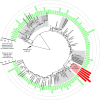Evidence of natural Wolbachia infections in field populations of Anopheles gambiae
- PMID: 24905191
- PMCID: PMC4059924
- DOI: 10.1038/ncomms4985
Evidence of natural Wolbachia infections in field populations of Anopheles gambiae
Abstract
Wolbachia are maternally transmitted intracellular bacteria that invade insect populations by manipulating their reproduction and immunity and thus limiting the spread of numerous human pathogens. Experimental Wolbachia infections can reduce Plasmodium numbers in Anopheles mosquitoes in the laboratory, however, natural Wolbachia infections in field anophelines have never been reported. Here we show evidence of Wolbachia infections in Anopheles gambiae in Burkina Faso, West Africa. Sequencing of the 16S rRNA gene identified Wolbachia sequences in both female and male germlines across two seasons, and determined that these sequences are vertically transmitted from mother to offspring. Whole-genome sequencing of positive samples suggests that the genetic material identified in An. gambiae belongs to a novel Wolbachia strain, related to but distinct from strains infecting other arthropods. The evidence of Wolbachia infections in natural Anopheles populations promotes further investigations on the possible use of natural Wolbachia-Anopheles associations to limit malaria transmission.
Figures




References
-
- World Health Organization. World Malaria Report: 2013 World Health Organization (2013).
-
- Ranson H. et al. Pyrethroid resistance in African anopheline mosquitoes: what are the implications for malaria control? Trends Parasitol. 27, 91–98 (2011). - PubMed
-
- Walker T. & Moreira L. A. Can Wolbachia be used to control malaria? Mem. Inst. Oswaldo Cruz 106, 212–217 (2011). - PubMed
-
- Hoffmann A. et al. Successful establishment of Wolbachia in Aedes populations to suppress dengue transmission. Nature 476, 454–457 (2011). - PubMed
-
- Bian G. et al. Wolbachia invades Anopheles stephensi populations and induces refractoriness to Plasmodium infection. Science 340, 748–751 (2013). - PubMed
Publication types
MeSH terms
Substances
Grants and funding
LinkOut - more resources
Full Text Sources
Other Literature Sources
Molecular Biology Databases

